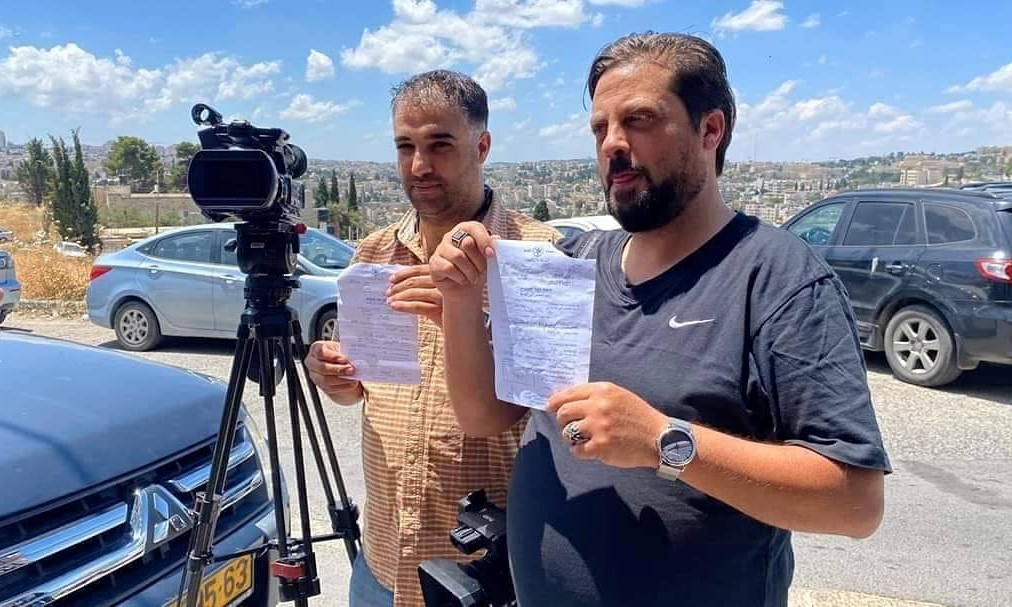The Palestine News and Information Agency (WAFA) reported on Sunday, June 7, that during the month of May it documented 27 violations committed by Israeli occupation forces against journalists and media institutions working in the occupied Palestinian territories. WAFA indicated that these violations by Israel against journalists included the firing of live ammunition, rubber-coated bullets and teargas canisters, in addition to physical beatings and arrests.
WAFA reported that 11 journalists were either injured by live fire or rubber-coated rounds, inhaled teargas, or were beaten by Israeli forces during the month. An additional 15 journalists were either arrested or targeted by Israeli gunfire but did not suffer injury. Other journalists, meanwhile, had their press cards revoked by Israeli soldiers.

Palestinian TV crew members display orders issued by the Israeli police to report for questioning by law enforcement officers, June 3, 2020. (Photo: PJS)
The report published on June 3 related how the Israeli military court at Ofer Prison sentence Mays Abu Ghoush, a student of media at Birzeit University, to 16 months in jail in addition to a fine of 2,000 shekels. Abu Ghoush was arrested on August 29, 2019, and was savagely tortured by Israeli interrogators during her first weeks of detention. On May 4, Israeli police detained Palestinian journalist Tamer Ebeidat, a correspondent of the Palestinian Ma’an News Agency, after raiding his home in occupied Jerusalem.
On May 10, Israeli occupation authorities ordered a renewed ban on the work of the official Palestine TV in occupied East Jerusalem for an additional six months, under the pretext that the Palestinian Authority, which is not allowed to operate in the city, operates the television station. On the same day, freelance journalist Karim Khamayseh was injured by Israeli soldiers who fired rubber-coated bullets at him while covering an Israeli army raid on the village of Kobar, near Ramallah.
On May 12, Israeli soldiers assaulted journalists Nasser Shtayyeh and Majdi Shtayyeh while they were covering the Israeli crackdown on the town of Ya’bad, in the north of the occupied West Bank. On May 14, Israeli soldiers assaulted and beat journalist Layla Hamarsheh after raiding her family’s home in Ya’bad.
On May 19, Israeli forces detained journalist Mohammad Ameen Abu-Daqqa, a cancer patient, at the Beit Hanoun border crossing on the Gaza-Israel border, while he was returning from Jordan where he had undergone chemotherapy for eight months. On May 23, Israeli occupation authorities ordered Adnan Najib, a freelance journalist, to not enter Jerusalem on the pretext of his alleged “incitement to violence and threatening Israeli security.” Other similar incidents of beatings, injuries, or the detention of journalists by Israeli troops were also documented during the last week of May.
In addition, Palestinian journalists are expressing solidarity with Eyad Hamad, 63, after the veteran cameraman working for the Associated Press (AP), was summarily fired from his post during May. Hamad openly criticized the Palestinian Authority for the arresting Anas Hawari, a reporter for the Hamas-affiliated Quds News Network. During a demonstration against Hawari’s arrest, Hamad stood alongside a number of his fellow journalists and held a sign that read: “President Mahmoud Abbas, I demand protection from the Palestinian security agencies.”
According the Palestinian Journalists Syndicate (PJS) Israeli forces committed a total of 760 violations and crimes against Palestinian journalists during 2019. A report issued by the freedoms committee of the PJS for all of last year recorded the incurring of injuries by journalists and media workers by Israeli occupation forces including 12 critically wounded by live ammunition, 62 injured by rubber-coated steel bullets, 58 hit by tear-gas canisters or stun grenades directly fired at them, and 78 cases of tear gas inhalation.


